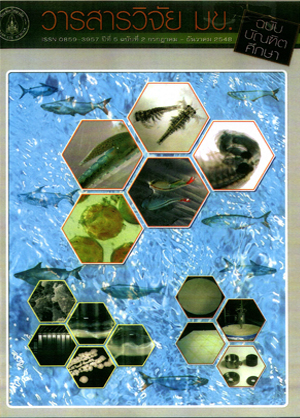การผลิตและศึกษาคุณลักษณะของเชื้อ3 Burkhoideria pseudomallei ที่มีการกลายของจีน,aroC และการประเมินศักยภาพในการนำมาใช้ เป็นวัคชีนเชื้อเป็นในหนูทดสอง CONSTRUCTION AND PHENOTYPIC CHARACTERIZATION OF AN AROC MUTANT OF BURKHOLDERIA PSEUDOMALLEI AND ITS POTENTIA
Keywords:
melioidosis, Burkhoideria pseudomalle, aroC geneAbstract
โรคเมลิออยโดสิส (Melioidosis) เป็นโรคติดเชื้อจากแบคทีเรีย Burkhoideria pseudomallei (B. pseudomallei) ทำให้เกิดการติดเชื้อที่รุนแรงทั้งในคนและสัตว์ ก่อให้เกิดอัตราการตายได้สูง ปัจจุบันยัง ไม่มีวคซีนที่มีประสิทธิภาพสำหรับ'โรคนี้ ในการสืกษาครั้งนี้ ได้ผลิตวัคซีนเชื้อเป็นชนิดที่ทำให้เชื้ออ่อนกำลังลง อย่างมีหลักการ โดยทำให้มีการกลายของจีน aroC ซึ่งสร้างเอ็นไซม่ใน aromatic biosynthetic pathway ใซในการลังเคราะห้สารพวก aromatic amino acids ไดแก่ phenylalanine, tyrosine, tryptophan, p-aminoben- zoic acid (PABA) และ 2,3-dihydroxybenzoic acid ซงเปนสารทจำเปนต่อการเจริญเติบโดของเชอเชอ วัคซีน (เชื้อ mutant) ที่มีการกลายของจีน aroC จีงลังเคราะห้กรดอะมิโนจำเป็นเหล่านี้เองไม่ได้ ต้องได้รับจาก ภายนอกเท่านั้น ซึ่งเซลล์ของคนและของสัตว์เลี้ยงลูกด้วยนมจะโม่มี pathway ดังกล่าว ทำให้ไม่พบสาร เหล่านี้ในเนื้อเยื่อต่าง ๆ ในปริมาณที่มากพอต่อการนำโปใข้ในการเจริญเดินโตของเชื้อ ทำให้เมื่อให้เชื้อ วัคซีนเข้าไปในร่างกายของคนหรือลัตวั เชื้อจะไม่สามารถเจริญเติบโตได้ตามปกดิ ซึ่งเชื้อที่พร่องจีนดังกล่าว จะอ่อนกำลังลง และการทดลองครั้งนี้จะผลิตเชื้อ mutant ในลักษณะที่ไม,มี antibiotic resistance marker
สอดแทรกอยู่ใน aroC gene เพื่อป้องกันการถ่ายทอดจีนดื้อยาไปสู่เชื้อจุลินทรีย์อื่นๆ เพื่อความปลอดกัย ในการนำไปใซีในคนหรือสัตว์ และประเมินศักยภาพในการนำมาใช้เป้นวัคซีนเชื้อเป้นเพื่0ป้0งสันโรค เมลิออยโดลิสในหนูทดลอง
ผลิตเชื้อ mutant โดยการโคลน functional aroC gene ของเชอ B. pseudomallei ทแยกได้จากผู้ป่วย โดยใช้หลักการ complementation ทำ In vitro mutagenesis โดยการตัดบางส่วนซองจีน aroC ออกไป ทำให้ จีนนี้สูญเสียความสามารถในการแสดงออก และถูกน่าเช้าไปแทนที่จีน aroC ปกติในโครโมโซมของเชื้อ B. pseudomallei (virulent wild type) โดยวิธีการ conjugation ตรวจสอบ phenotype ของ mutant โดยดู
การพึ่งสาร aromatic และตรวจสอบ genotype โดยวิธี Southern blotting และ PCR ชงได้เชอ B. pseudomallei aroC mutant จำนวน 2 โคลน ชึ่งมีคุณลักษณะดังด้องการ ตรวจวัดระดับ attenuation และประเมินความสามารถ ของเชื้อ B. pseudomallei aroC mutant ในการกระตุ้นให้เกิดภูมิคุ้มกันโรคเมลิออยโดสิสในหนูทดลองสายพันธุ BALB/C และ C57BL/6 ทางซ่องห้อง ผลพบว่ามีระดับการอ่อนกำลังลงอย่างมากที่ระตับ LD เท่ากับ 1.96
50
X 106 CFU และ 7.7 X 107 CFU ตามลำดับ ผลการตุ้มกันโรคพบว่าสามารถกระตุ้นให้เกิดการตุ้มกัน โรคเมลิออยโดสิสได้ในหนูสายพันธุ C57BL/6 แต่ไม่สามารถตุ้มกันโรคได้ในหนูสายพันธุ BALB/C เมื่อถูก challenge ด้วยเชื้อ B. pseudomallei (virulent wild type) ที่ระดับ LD&0 ต่าง ๆ กัน แสดงว่าความสามารถ ในการตุ้มกันโรคของเชื้อวัคซีนชนิดนี้ชื้นกับชนิดของ host ที่แตกต่างกันด้วย
ABSTRACT
Burkholderia pseudomallei is the causative agent of melioidosis, a severe disease of humans and animalร. Presently no vaccine exists to protect against melioidosis. The aroC gene, which catalyses the last step of the aromatic amino acid biosynthesis pathway, encodes chorismate synthase, and bacterial with defective aroC gene are auxotrophic for certain aromatic compounds such as tryptophan, tyrosine and phenylalanine as well as para-aminobenzoic acid and 2,3-dihydroxybenzoate. In mammalian tissues, some of these compounds are not available at sufficient levels to sustain growth of these mutants, rendering them attenuated independent of the status of the host immune system. We have constructed and characterized a marker-free aroC auxotrophic mutant of Burkholderia pseudomallei and also evaluated its potential as a live vaccine in BALB/C and C57BL/6 mouse model. The deletion was fully defined at the molecular level with no foreign DNA or drug resistance gene was shown to be present in the B. pseudomallei genome. Two independent aroC mutants were isolated and confirmed phenotypically by their dependence on aromix supplements and genotypically by Southern hybridization and PCR. One mutant was chosen for further study and shown to be highly attenuated with the LD50 of 1.96 X 106 CFU in BALB/C mice and 5 X 108 CFU in C57BL/6 mice when immunized via intraperitoneal route. Therefore, attenuation is due to starvation in vivo for an essential aromatic metabolite. As a test of the vaccine potential, mice were immunized with aroC mutant and subsequently challenged with virulent parental B. pseudomallei strain A2 by intraperitoneal routes. The results showed that this vaccine was capable of protecting the C57BL/6 mice against challenge with 183 CD of the parental strain. However, this vaccine was not able to induce protection in the BALB/C mice against a challenge dose of 25 LD f or higher lethal dose of the parental strain. The results of this study show that the ability to induce a protective immune response of this vaccine depends on the immune response of the difference strain of mice.



